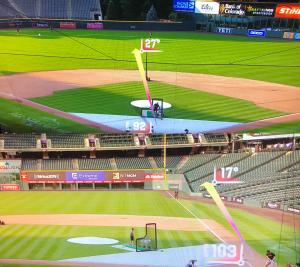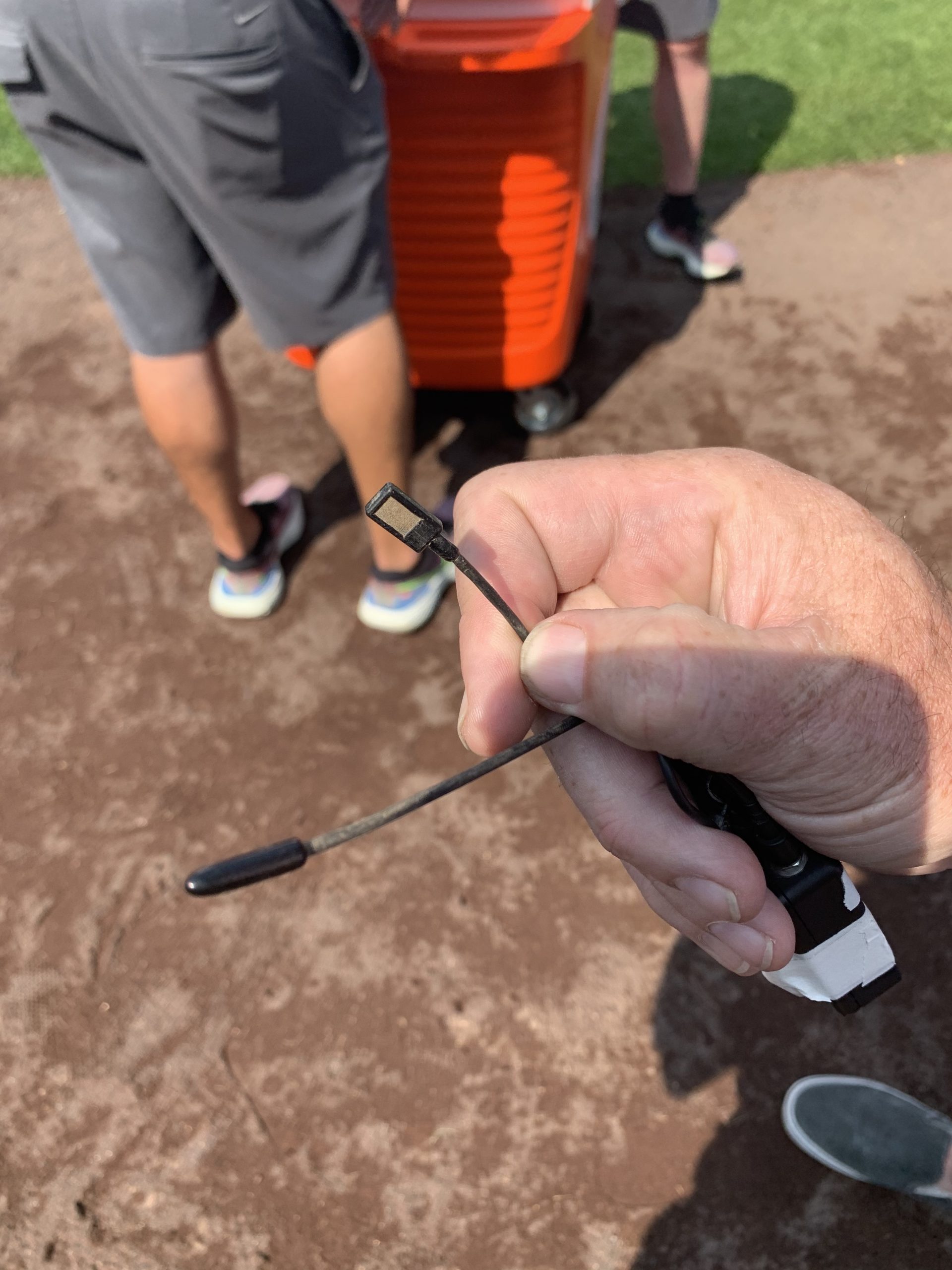Live From MLB All-Star 2021: ESPN Enhances Statcast AR Graphics for Home Run Derby, Produces Draft From Coors Field
ESPN has five NEP mobile units onsite for this year’s event
Story Highlights
Denver’s Coors Field is a power hitter’s heaven, and, for batted balls flying all over the place during tonight’s Home Run Derby, ESPN will showcase this year’s Statcast-driven alternative broadcast with reimagined on-air elements and other real-time augmented-reality (AR) overlays on ESPN2. Yesterday, the broadcaster highlighted its MLB Draft coverage with a remote production from the compound.
“Our alternative Statcast presentation offers us a great opportunity to test the [production] waters,” says Phil Orlins, senior coordinating producer, ESPN. “We’ve always differentiated our Home Run Derby coverage on ESPN2, but, this year, we’ll have a really aggressive plan to differentiate visual coverage of each at-bat with augmented reality.”
High Fly Balls: Statcast’s New Look Has Real-Time Arrow, Target Graphic
Since debuting at the 2018 MLB All-Star Game in Washington, DC, a Statcast-centric production has captured the attention of both younger fans and diehard fans who are into new-age analytics. In 2019, the broadcaster continued execution of 3D spray charts and, this year, will implement them on the aerial FlyCam system that will soar across the outfield grass after the conclusion of each batter’s round.
For a twist making its Home Run Derby debut, ESPN worked closely with Major League Baseball on real-time augmented-reality graphics. The overlay will display an arrow pointing in the direction of the batter’s calculated launch angle with exit velocity at the bottom. As the ball travels through the air and lands in the stands, the alternative broadcast will show a target with the ball’s accurate distance.
“In 2018, [advanced analytics] weren’t as mature and well-developed as they are now,” says Orlins. “Now fans are constantly seeing it.”
Seen during the 2019 Derby, a two-box format is being deployed to accommodate the fast pace of the event. Paired with these new AR activations, the Statcast edition will keep the batter on the left side of the screen and toggle between a high-home-plate view and angles from both the first- and third-base sides. In previous iterations, Orlins and his staff had to react quickly and potentially miss a ball landing in the crowd.
“The best-case scenario was a home run being hit and the next pitch coming right as the ball landed,” Olins notes. “The primary box [on the right] is pretty frenetic, with balls being hit into the air, balls landing, and other reaction shots. Committing to this split screen has been one of the biggest enhancements that we’ve made over the last five years.”
Compound Workflow: NEP Trucks Handle Robust Derby Coverage
In the compound, all studio shows, the main presentation, and Statcast edition of Monday’s slugfest will be produced from five separate NEP trucks: ND4 A and B units, Black, Red, and Super B. To produce this high-profile event, the quintet of mobile units will unfortunately be different from what ESPN is accustomed to using.
“The mobile units that we’ve used for this event in the past were not available due to the overlap in sports that is happening right now,” explains Cindy Pennington, project manager, ESPN. “Along with crewing, these were some of the challenges that we’ve had to deal with this year and had to rethink things.”
The rethinking of production elements has extended far beyond the compound. During other years, ESPN would construct its infrastructure for the Derby on Monday, break down the equipment, and allow Fox Sports to erect its dedicated devices. This year, both broadcasters are following a more streamlined plan, sharing specific resources within the venue.
“Since we use similar camera positions, we finally said, ‘Hey, why are we building on one day and you’re building another day?’” says Pennington. “We’ve worked together on cabling and other workflows, and that has been a huge help for both of us.”
On the camera front, ESPN will serve up engaging views for the at-home viewing audience. In addition to the FlyCam, the network will have a stealth tower robotic camera in the middle of the field to show each pitch, multiple super slo-mo robos in front of home plate, a Phantom camera, and a shallow depth-of-field camera.
Down and Dirty: Derby Audio Goes Into the Ground
ESPN will have a fair share of the cameras covering the progress of tonight’s Derby, and its audio coverage is no less impressive. Tasked with bringing the crack of the bat and the feel of a towering home run, technicians have installed an array of microphones in certain areas around the field, including the dirt portion around home plate. Since the All-Star Game and its Home Run Derby take place in a new venue every season, the audio team learns to adapt to the schedules and workflows of each facility’s grounds crew. To make sure this procedure runs as smoothly as possible, the broadcaster accurately follows the home team’s rules.
“One of the biggest challenges has always been working together with the grounds crew,” says Kevin Cleary, remote operations specialist, ESPN. “This area is usually hallowed ground for them, and allowing us to dig into their infield to place microphones was a big hurdle to get by. Once they realize that we’re respectful of their space and we treat their ground as if it was ours, we do the insertion and extraction with a member of their team, and we try to leave the infield in the same condition that it always is.”
This year, the crew buried four Quantum Q5X systems after the conclusion of the 2021 MLB Futures Game and before the MLB All-Star Celebrity Softball Game. The time-sensitive process is extremely important to bringing the full breadth of the Home Run Derby to fans watching at home, but the moment is also filled with tension and pressure.
“We sometimes have to bury them earlier, and, other times, we have to bury them extremely close to game time,” notes Cleary. “It’s usually a scramble because you don’t have much time [to work with] for a Major League Baseball game, so you have to get in and out of there pretty quickly.”
Full Schedule: Two-Hour Baseball Tonight, Loaded Talent Line-Up From Coors Field
Before homers soar over the fence, tonight’s action will be teased with a two-hour edition of Baseball Tonight Presented by T-Mobile at 4 p.m. ET on ESPN. Kevin Connors will host with analysts Tim Kurkjian and Kyle Peterson. At 7 p.m., the talent line-up will expand with the addition of Karl Ravech, Eduardo Perez, and Senior MLB Insider Jeff Passan. Simultaneously, a Statcast-flavored version of Baseball Tonight will be feature play-by-play announcer Jason Benetti, analyst Jessica Mendoza, and MLB Statcast analyst Mike Petriello on ESPN2.
On the network’s digital platforms, BBTN Live will stream live on Facebook, Twitter, YouTube, and the ESPN App at 7:30 p.m. with Joon Lee and Clinton Yates.
Starting at 8 p.m., the traditional broadcast of the Home Run Derby on ESPN will feature Ravech, Perez, and reporters Buster Olney and Marly Rivera. On ESPN2, the Statcast edition will be called by Benetti, Mendoza, and Petriello.
Next Gen: MLB Draft Plans Include Remote Effort, Studio Set
Yesterday, for the first time, the MLB Draft took place during the All-Star schedule. Located at the Bellco Theatre at the Colorado Convention Center, the event announced the league’s latest prospects with a handful of ESPN talent and production firepower.
“The Bellco Theatre is only about a mile and a half away, so we did a REMI [production from] one of the mobile units in the compound,” says Pennington, adding, “We also have integration with resources in Bristol.”
The production used a lot of ESPN’s technologies but also tapped into the shared resources of MLB Network. With nearly 50 remote feeds of players and team executives, ESPN built off its relationship forged during last year’s virtual Draft.
“We were very excited to be back doing the MLB Draft and partnering with MLB Network,” says Orlins. “They were wonderful partners on the technological and production side because they allowed us to produce the event to the best of our ability.”
On the talent side, the broadcaster’s home for its Draft coverage was a stage-side studio offering immediate reactions to each of the night’s picks. Ravech was joined in-person by MLB Insider Kiley McDaniel with Perez and Peterson as analysts. Another analyst, Chris Burke, was brought in remotely over Zoom from his home. Around the venue, Passan and Mendoza provided ancillary support to the telecast.

On set from left: Kyle Peterson, Eduardo Perez, Kiley McDaniel, and Karl Ravech worked at a studio at Bellco Theatre during ESPN’s MLB Draft coverage.
MLB’s Power Showcase: ESPN Revels in Return to All-Star Festivities
ESPN has mastered the art of the “at-home” production over the past 16 months, but a few events on the MLB calendar barely resemble a normal production. The MLB Home Run Derby is always a big draw, and, with a long hiatus that has baseball fans hungering for a return to the ballpark, crowds at Coors Field are expected to reach max capacity.
For Pennington, the first female operations specialist in the company’s history, this year’s Midsummer Classic means a lot on a personal level: “I was walking through the concourse, and the sound of fans caught me off guard because it has been such a long time since we’ve been in a stadium with a large crowd. You can feel the excitement, and it makes for a great environment.”
ESPN’s coverage of tonight’s 2021 MLB Home Run Derby begins with a two-hour pregame show at 4 p.m. ET.
For more coverage from the 20201 MLB All-Star Game in Denver, click HERE.






